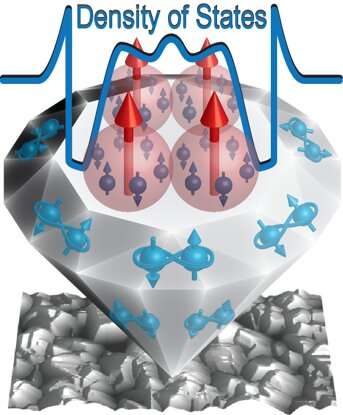Delocalized states within the superconducting gap

Everyone knows that "diamonds are forever." The brilliantly shining stones make for magnificent jewelry and represent carbon in its most prestigious form. What most people do not know, however, is the fascinating physics that can take place within this material.
We have been investigating the properties of diamond thin films for several years now, trying to uncover the mysteries that lie beneath the sparkling surface of diamond. We are growing diamond films on silicon substrates, which makes them directly compatible with today's silicon-based devices, and therefore particularly interesting for applications.
During the growth of the diamond films, small amounts of boron are mixed in with the diamond. The amount of boron changes the color and electrical properties of the diamond.
Diamond in its purest form is an electrical insulator, unable to carry any current. Increasing the amount of boron changes its color from clear to light blue, and the insulator into a semiconductor. Adding more boron will turn the diamond film brightly blue, making it metallic. When even more boron is added, the film turns pitch black.
Ferromagnetism and superconductivity—two mutually antagonistic states (?)
We have found previously that such black diamond thin films are, on the one hand, ferromagnetic, and on the other hand, when cooled to very low temperatures, they become superconducting.
Ferromagnetism and superconductivity are not usually found in the same material. Those few materials that do show both effects are therefore even more interesting to study.
Superconductivity is a state of matter in which a material can transport current without losses across a very large distance. Furthermore, superconductors are perfect diamagnets, expelling all magnetic fields. This phenomenon allows magnets to levitate above a superconductor and vice versa.
When a material becomes superconducting, its electrons condense into Cooper pairs, which opens up a large gap in the energy spectrum of the superconductor. Within this gap, no energy states are available.
Delocalized Yu-Shiba-Rusinov states
In our new study, we found, for the first time, long Yu-Shiba-Rusinov (YSR) bands within the energy gap of diamond thin films, adding another fascinating aspect to diamond in an area of physics that has only recently been unlocked.
Yu-Shiba-Rusinov states are energy states that can occur within the energy gap of a superconducting material when a magnetic perturbation is present. These states were independently predicted by three scientists, L. Yu, H. Shiba, and A. I. Rusinov, at the end of the 1960s, and have only recently been confirmed experimentally.
YSR states are usually highly localized, extending only over a few atomic distances, which is what makes them appealing for qubits. However, we discovered delocalized YSR states within the superconducting gap of diamond thin films. The YSR states extend over several tens of nanometers forming YSR bands.
This enhanced spatial extent of the YSR states has never been observed before, and opens the route toward topological quantum devices in which magnetic systems can be remotely coupled.
This story is part of Science X Dialog, where researchers can report findings from their published research articles. Visit this page for information about ScienceX Dialog and how to participate.
More information:
Gufei Zhang et al. Yu-Shiba-Rusinov bands in ferromagnetic superconducting diamond, Science Advances (2020). DOI: 10.1126/sciadv.aaz2536
Bio:
Johanna K. Jochum was born in 1987 in Bludenz, Austria. She obtained her BSc and MSc from the Federal Institute of Technology (ETH) Zurich. She performed her doctoral research on interface phenomena in magnetic nanostructures and obtained her PhD from the KU Leuven in 2018. Since 2018, she has been working at the resonant spin-echo neutron spectrometer RESEDA at the Heinz Maier-Leibnitz Zentrum, Garching, Germany.